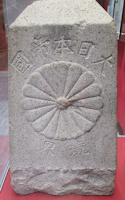Archival Bricolage
- Peripheral Histories ISSN 2755-368X
- Jul 20, 2016
- 5 min read
By Carrie Crockett
Over the past few years, I have been researching Russia’s efforts to colonize Sakhalin during the 19th century. The island, situated seven miles east off the Eurasian continent and twenty-five miles north of Japan (on a clear day it can be glimpsed from both coasts), was a contested frontier space for over one hundred years, and some would argue that it remains so.

During the 19th century, Sakhalin attracted the attention of multiple nations because of its fortuitous geopolitical position at the mouth of the Amur River and proximity to expanding North Pacific trade. These combined factors caused the Russian explorer, Gennadii Nevel’skoi, to look past the island’s indigenous groups in 1849 and claim the territory as Russian. Images of virgin coal deposits and geographical expansion in mind, it was Sakhalin that caused Tsar Nikolai I to declare, “Where the Russian flag has once been raised it shall never be lowered.” In an effort to undertake mining on the island as well as forced colonization, laborers were sent to Sakhalin in the 1850s; forced settlement of the island soon followed in the form of a Russian penal colony in 1868. Because of its cultural isolation from St Petersburg and its status as a penal colony, (as well as its terrible weather), the island became known as the “isle of ill repute,” the “land of despair,” and “the place of the dead.” Chekhov, in 1890, wrote that as his boat approached Sakhalin he felt he was about to sail off the edge of the earth.
My research into the Sakhalin penal colony (1858-1905)—and particularly the prison’s women and children—has taken me to a number of regional archives in the North Pacific: on Sakhalin, in Vladivostok, and at Hokkaido University’s Northern Collection in Japan. I have bolstered these efforts by traveling to collections in Washington D.C., Moscow, and to the Hoover Institute at Stanford in California, in addition to other university collections. At each location I have been struck by the archival abundance concerning certain topics, and the relative paucity of materials regarding Sakhalin.

Frontier regions, frontier archives
As is common to frontier regions, Sakhalin was a space in which numerous ethnicities and sovereign nations vied for economic and political dominance, creating multiple sets of historical records but also levels of tension that might ultimately contribute to their loss. Such was the case with Sakhalin. The contest over Sakhalin’s possession and fishing rights, which figured prominently in the Russo-Japanese War, (1904-1905) led to Russia ceding the southern half of the island to Japan before it evacuated its citizens from the region. As the prisoners of the colony were transported to the Russian mainland, however, they were simply deposited on the shores of de Castries Bay. Planning for supplies, shelter, or transport to other Russian prisons had been overlooked amidst the conflict’s chaos. The majority of the Russian convicts and their families simply disappeared into the landscape, vanishing into the vastness of the Russian Far East.
Border stones marking the north-south boundary between Russian and Japanese territory after the Russo-Japanese War
It was during those closing days of the war that many records of the Russian penal colony also disappeared. Administrative files were burned, both by the retreating Russians and the advancing Japanese army. For this reason, many of the sources that I might desire—prisoner files, administrative reports, unpublished memoirs, records describing the day-to-day procedures of the colony—are in extremely short supply. Although some administrative documents can be found in Vladivostok and in Moscow, subaltern texts of Sakhalin are in short supply. Especially given my thematic focus on a group that tends to be underrepresented within even the most robust of archival environments—women—I have turned toward unearthing the past by using a bricolage of sources.

The absence of women’s personal files, photographs and other records has provided me with an opportunity to think deeply about archival loss, about the natural limitations of official archives, and about historiography. Because state records regarding 19th century Sakhalin are full of empty spaces, I have sought linkages to the past in non-official repositories. One useful technique has been to back into history by undertaking a study of the present. By studying the histories of cities in the Russian Far East—Irkutsk, Blagoveshchensk, Harbin—to which some prisoners traveled post-evacuation in search of new lives, I have been able to trace the movements of some prisoners who otherwise evade archival mention. Genealogical databases have played an important role in linking children to their parents and grandparents, originally Sakhalinian prisoners. Such work is admittedly painstaking but has nevertheless proven fruitful. The records of foreign fishing concerns, such as those that were once involved in the area’s fishing and seaweed processing, have been especially helpful. Entrepreneurs from Europe and America established fisheries and dry goods businesses on Sakhalin during the 1880s and 1890s; prisoners often became their employees. Also, in the absence of individual prisoners’ medical records, I have mined local contemporaneous newspapers for information relating to the spread of illnesses from town to town. These, coupled with online cemetery records, have produced names that otherwise might remain lost in the conflation of the Russo-Japanese conflict.
As an historian of penal history I am well aware of the value of details imbedded in interviews conducted with journalists, prison inspectors, and prison doctors. The notes of anthropologists who studied the island’s indigenous groups are excellent sources as well. I have found the only existing references to common-law marriages between Russian exiles and native women within such records. The personal letters of travelers and penal enthusiasts have similarly yielded dates and connections of which I otherwise would have not been aware.
My hope in the capability of the unofficial archive to produce historical material has compelled me to cast new sorts of nets as well, some of which I had never considered prior to this project. I have written to third-generation residents of Sakhalin asking for interviews, purchased bundles of 19th century postcard correspondence on EBay, studied geologists’ sketches and read the diaries of Japanese fishermen. I have combed through Soviet travel brochures and historical leaflets seeking mention of Sakhalin’s pre-revolutionary, anti-tsarist heroes. Although, admittedly, a sense of research desperation has often inspired such steps, the unofficial archives, unlike the official ones, have not maintained silence. At times, circuitous routes into the past have yielded valuable information.
All this notwithstanding, there is no substitute for the individual’s own voice and story. At best, the strategies I have mentioned represent but a beginning point from which I always am attempting to connect with more individual, more detailed, and more subaltern sources. Amidst my angst over the absence of meticulously kept files and detailed finding aids, however, scholars such as Carolyn Steedman and Antoinette Burton have reminded me that even the most expansive state archive can nonetheless be limited in its own politicized, performative way. Burton’s well-known statement—that “the history of the archive is the history of loss”[1]—must be true, to some extent, within every archival context. Archival silences, gaps and omissions must therefore not be mistaken for the demise of a research goal.
Carrie Crockett is a third-year Ph.D. student in the History Department at the University of Leicester; she also works on the European Research Council funded project, Carceral Archipelago: Transnational Circulations in Global Perspective, 1415-1960. She is currently writing her thesis on the importance of women's economic contributions to the development of the Russian Far East during the 19th century.
__________________________________________________________________________________
[1] Antoinette Burton, ‘Thinking Beyond the Boundaries: Empire Feminism and the Domains of History’, Social History26:1(2001), p. 66.






